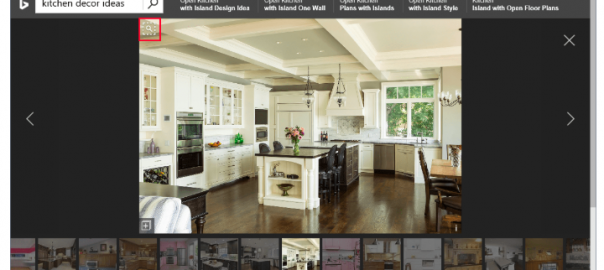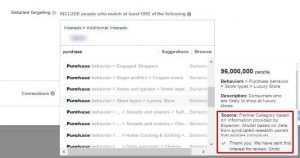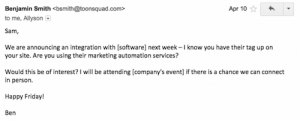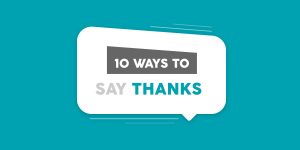— June 22, 2018
Bing SEO?
Yes, Bing SEO. Though most think immediately of Google in terms of SEO, those who don’t consider Bing are missing out on a valuable opportunity to rank higher and gain more traffic.
Below, I’ll give you eight reasons you should be focusing on your Bing SEO.
-
Bing SEO Has Less Competition
We’ll get the most obvious out of the way first.
Clearly, we enjoy a web dominated by Google. In fact, we don’t even “search” for things on the web anymore; we “Google” them.
That means that most websites are working hard to push their way to the top of Google – and spending far less time optimizing for smaller sites like Bing.
Also keep in mind that Bing comes in second behind Google in terms of search traffic, making up 30% of searches.
But these aren’t limitations. They’re opportunities.
While your competitors are busy improving SEO for Google, it gives you a great opportunity to capitalize on Bing. This is especially useful for smaller sites who may have had trouble cracking the first page of Google.
It’s also a great opportunity for newer business to gain notable traffic. Veterans in the biz have likely spent years building up their Google presence, making it incredibly difficult for new businesses to compete.
- Top brands tend to rank higher, just as they do on Google.
- Social signals correlate very closely with higher rankings.
- Backlink numbers are closely linked to higher rankings as well.
- Relevant and quality content are important for search rankings.
- On page technical factors also play an important role.
-
Bing SEO: Social Signals Count
One of the biggest differences between the Google and Bing algorithms is that Bing does count social signals as a ranking factor.
Google has long insisted that social signals is not, in fact, a ranking factor (though there’s plenty of evidence to suggest it’s an indirect ranking factor.)
But Bing, on the other hand, is up-front with its use of social signals.
That means that well-positioned results in Bing often tend to have a higher number of shares, likes, tweets, and +1s, and specific URLs stand out in top results that have a high mass of social signals.
This is great news for any business that’s invested heavily in a social media strategy. Not only are they creating more audience engagement, when it comes to Bing, they’re boosting their rankings as well.
-
Bing SEO: Bing’s Upfront About Its Ranking Factors
When it comes to Google, ranking factors are often a guessing game.
And while Bing doesn’t disclose all the details, it is much more open how and what websites can do to rank higher in the SERPs.
For obvious reasons, this takes a lot of the guesswork out of optimizing your website.
Bing walks you step-by-step through the start-up process, and lists helpful resources regarding their ranking factors in their webmaster guidelines.
Even better, Bing offers free tools to help you start your SEO plan.
The first, located in the Reports & Data section of your account, is called SEO Reports.
These reports will automatically run on your site every two weeks and return with suggestions about how you can improve your SEO.
The second, found in the Diagnostics & Reports section, is Bing’s SEO Analyzer.
This one you can use at your own discretion, and scan any single page and prepare a report for you immediately.
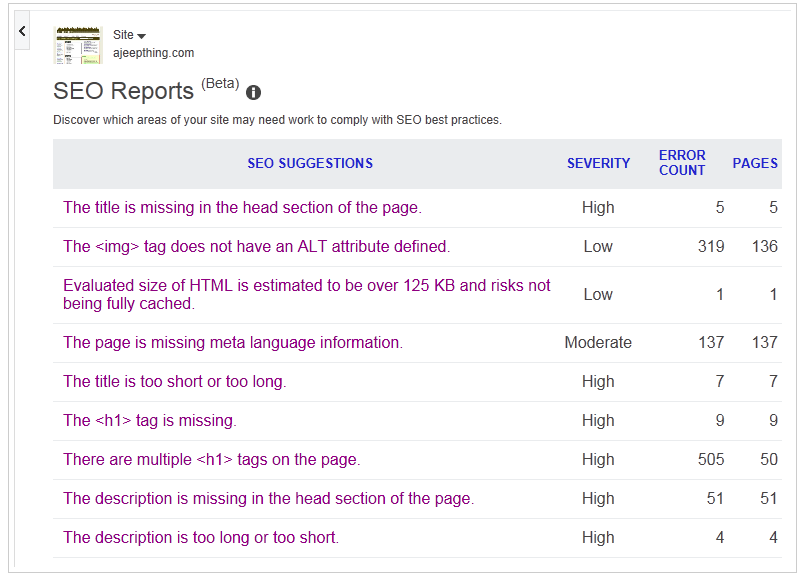
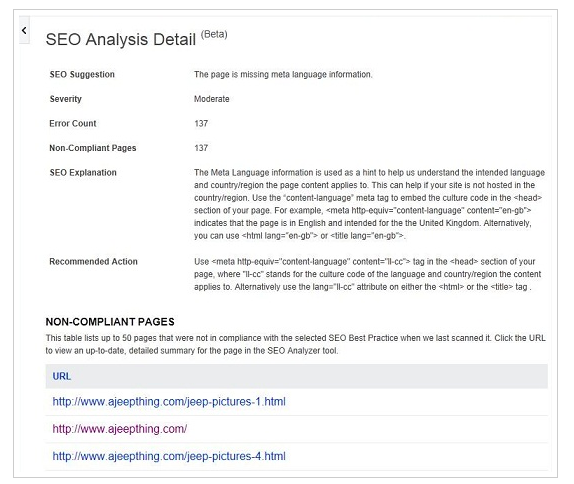
As you can see from these images, the reports are detailed and based on a set of 15 SEO best practices. Clicking on one of the suggested items will lead you to an SEO Analysis Detail, which will give you more information on each individual suggestion.
-
Bing Image Search is Better
Hands down, Bing beats Google when it comes to image search.
Image search is Bing’s thing.
But you might already know that.
The browser has long offered sharper and higher-quality images than Google, and has become one of its best-known advantages.
It beat Google to the infinite scroll design, and has the upper hand when it comes to filtering images.
Unlike Google, Bing allows users to filter images by layout – tall, wide, or square.
In terms of SEO, it offers a huge opportunity for brands to rank based on their images.
But Bing goes beyond traditional when it comes to image search.
In 2017, Bing introduced the Visual Search Button. This small magnifying glass allows users to click on any object in the photo, and Bing will then pull matching images as well as do its best to pull up product pages.
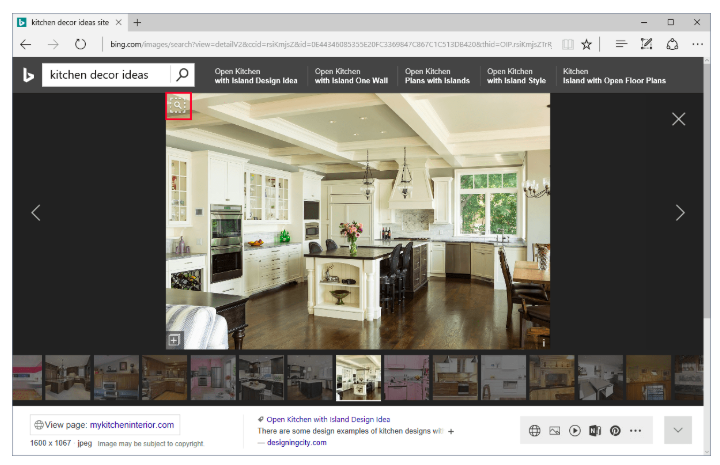
I hardly need to tell you that for e-commerce brands especially, this is major.
It represents an entirely new opportunity to introduce searchers to their products and outdoes Google in terms of image searching.
So if you need a little refresher on your image SEO, watch the video below.
-
Bing Could Have a Lower Bounce Rate
This is big news for Bing.
Long hailed as secondary to the almighty Google, Bing traffic has been labeled second-best.
But according to blogger Matthew Woodward, that may not actually be the case.
By analyzing his own traffic, he found that traffic from Bing:
- Has a lower bounce rate
- Visits more pages
- Spends more time on site
- Subscribes to lists more
Why the increase?
Well, we can’t know for sure. We do know that relevant, quality content and strong user engagement are huge SEO factors for Bing (even stronger than for Google).
Engagement metrics like bounce rate and time on site generally mean that your content is useful to your audience, causing an increase in rankings.
So, it stands to reason that because Bing puts so much emphasis on engagement metrics, sites that continuously produce high-quality content tailored to their target audience will perform even better on Bing.
-
Bing Ads Are Have Cheaper CPCs – And Less Competition
This one technically falls inside the SEM scope, but it’s a serious benefit of Bing that can’t be ignored
PPC marketing on Bing works very similarly to Google: both use an auction system and operate on a cost-per-click basis.
The big benefit for Bing is that due to the lack of competition on the site, advertisers are generally able to claim better ad positions and cheaper CPCs.
In fact, Wordstream reports that on average, their clients saw a 33.5% cheaper CPCs on Bing.
On top of that, those ads generally had better positions and a higher CTR.
This comes as especially good news for Bing users in light of recent ad spend reports.
According to iProspect’s 2017 Paid Search Trends Reports for Q2, CPC is at an all-time high. Mobile costs alone had increased by 17% in Q1 and up 52% year-on-year.
The trend isn’t going anywhere, with iProspect projecting that businesses will increasingly have to pay more to maintain their current positions.
The silver lining here, of course, is Bing.
Because its costs are lower to begin with, you can expect to continue to pay less using the Bing Network Audience.
-
Bing SEO: HTTPS isn’t a Ranking Factor
When Google announced they would be counting HTTPS as an official ranking factor, it made a few waves in the marketing community.
The addition was made to encourage webmasters to help secure the web.
Surprisingly, Bing had an announcement of their own: they would not be counting HTTPS as part of their ranking signals, according to Bing’s Vincent Wehren.
He explained that Bing’s goal is to “give searchers content they want” and feels that HTTPS isn’t relevant in site rankings.
For some marketers, this is welcome news.
While there’s no real downside to migrating to HTTPS, it can result in a drop in traffic if the migration isn’t handled properly.
For those unwilling to take the risk, Bing’s stance on the subject may be more your speed.
-
Bing SEO: Bing’s Audience Spends More
Here’s a cool stat for you: the Bing Network audience spends 34% more online when shopping from their desktop computers than average internet searchers.
That means that Bing users, on average, spend more than any users on any other search engine (I’m looking at you, Google).
You may be wondering what it is about Bing that gets users to open their wallets.
Well, we can’t know for sure, but we can make a few deductions based on Bing’s audience.
First, nearly 40% of Bing’s audience is between the age of 35-54 years old, and over a third of its audience has a household income of $ 100,000 or more.
Additionally, over a third graduated with a Bachelor’s degree, and 17% graduated from graduate school.
So what does all that mean?
Bing’s audience is educated, has money to spend, and are at a time in their lives when they can afford to do so.
Clearly, the spending power is there. And if that happens to fit your target audience, you’re in serious luck.
But there’s more to be said for the Bing audience.
Turns out, Bing users are loyal to their search engine.
In fact, Bing reports that it reaches 66 million searchers not reached on Google across all industries.
That’s valuable traffic right there, and most businesses simply can’t afford to ignore it.
Conclusion
Despite any personal preferences you might have regarding search engines, the stats don’t lie: 1 in 5 searches still happen on Bing.
For most marketers, that’s a number worth capitalizing on.
The best part is that you’re probably already optimizing your site Bing. The process isn’t so different from Google’s, and with a few tweaks (and a good look at Bing’s guidelines), you’ll be ready to scale the top of the Bing SERPs.
Digital & Social Articles on Business 2 Community
(92)
